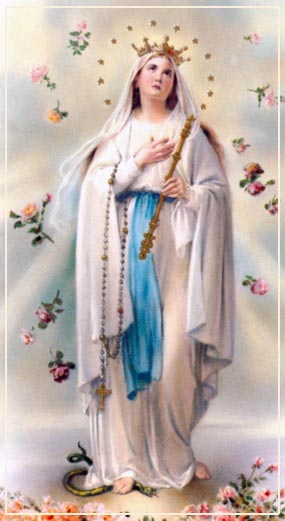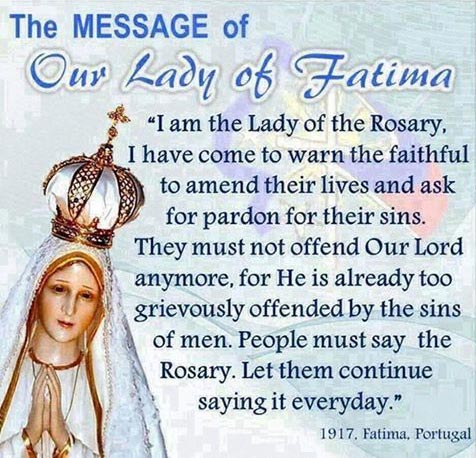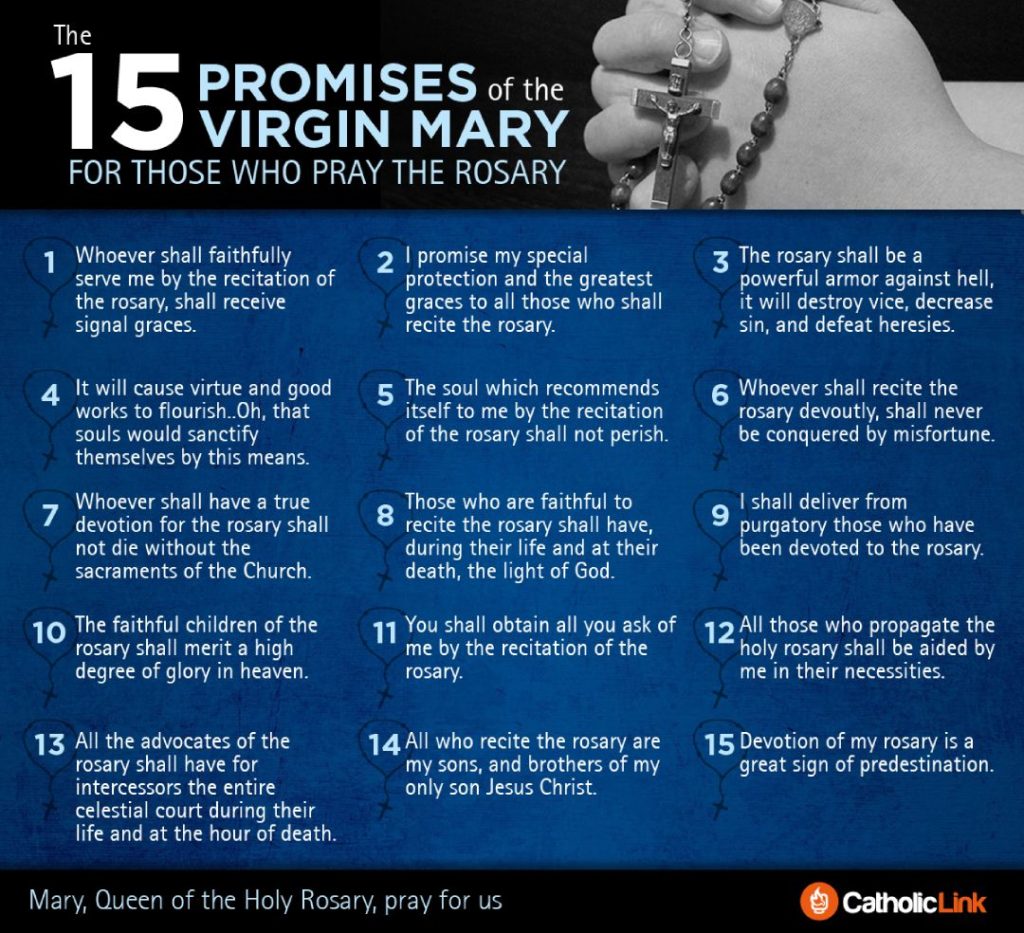7 October
Feast
Our Lady of the Rosary

The feast of Our Lady of the Rosary was instituted to honor Mary for the Christian victory over the Turks at Lepanto on October 7, 1571. Pope St. Pius V and all Christians had prayed the Rosary for victory. The Rosary, or the Psalter of the Blessed Virgin Mary, is one of the best prayers to Mary, the Mother of God.
Pope Benedict XVI invites all families to pray the Rosary for the intentions of the Pope, the mission of the Church and peace. “It is as if every year Our Lady invited us to rediscover the beauty of this prayer, so simple and profound.” The Rosary, a “contemplative and Christocentric prayer, inseparable from the meditation of Sacred Scripture,” is “the prayer of the Christian who advances in the pilgrimage of faith, in the following of Jesus, preceded by Mary,” said the Pontiff.
COLLECT PRAYER
Pour forth, we beseech you, O Lord, your grace into our hearts, that we, to whom the Incarnation of Christ your Son was made known by the message of an Angel, may, through the intercession of the Blessed Virgin Mary, by his Passion and Cross be brought to the glory of his Resurrection. Who lives and reigns with you in the unity of the Holy Spirit, God, for ever and ever.
Things to Do:
- Pray the Rosary, or 5 decades of the Rosary tonight with your family. Continue this practice through October, the month that is especially dedicated to the Rosary.
- Read the encyclicals on the rosary, and the latest apostolic letter.
- Learn the Luminous Mysteries. For families with younger children, it helps to have visual aids for the mysteries. Have a picture to flip at the beginning of each decade for the family Rosary.
- Learn how to make rosaries, cord and/or wire for missions.
- Learn about the great victory of Our Lady at the Battle of Lepanto. You can also read more about Pope St. Pius V, who instituted the Feast of Our Lady of the Rosary.
- Read Cardinal Angelo Sodano’s homily at the Shrine of Our Lady of the Rosary.
- “The Rosary, or Psalter of the Blessed Virgin Mary, is one of the most excellent prayers to the Mother of God.” Read the Directory on Popular Piety and Liturgy on the Rosary, particularly encouraging the practices of:
- The recitation of the Rosary could be made more solemn in tone “by introducing those Scriptural passages corresponding with the various mysteries, some parts could be sung, roles could be distributed, and by solemnly opening and closing of prayer.”
- The custom of making an insertion in the recitation of the Hail Mary, which is an ancient one that has not completely disappeared, has often been recommended by the Pastors of the Church since it encourages meditation and the concurrence of mind and lips.
Insertions of this nature would appear particularly suitable for the repetitive and meditative character of the Rosary. It takes the form of a relative clause following the name of Jesus and refers to the mystery being contemplated. The meditation of the Rosary can be helped by the choice of a short clause of a Scriptural and Liturgical nature, fixed for every decade.
- St. Pius V was a very holy Dominican, who wore his scratchy habit underneath his papal robes, and walked around Rome barefoot. He ate just to sustain himself, and fasted frequently. We should use his example and remember to fast and pray the Rosary for the conversion [of hardened hearts].
Source: CATHOLIC CULTURE
A brief history of how the feast came to be
Source : CATHOLIC NEWS AGENCY
On October 7, the Roman Catholic Church celebrates the yearly feast of Our Lady of the Rosary. Known for several centuries by the alternate title of “Our Lady of Victory,” the feast day takes place in honor of a 16th century naval victory which secured Europe against Turkish invasion. Pope St. Pius V attributed the victory to the intercession of the Blessed Virgin Mary, who was invoked on the day of the battle through a campaign to pray the Rosary throughout Europe.
The feast always occurs one week after the similar Byzantine celebration of the Protection of the Mother of God, which most Eastern Orthodox Christians and Eastern Catholics celebrate on October 1 in memory of a 10th-century military victory which protected Constantinople against invasion after a reported Marian apparition.
Pope Leo XIII was particularly devoted to Our Lady of the Rosary, producing 11 encyclicals on the subject of this feast and its importance in the course of his long pontificate.
In the first of them, 1883’s “Supremi Apostolatus Officio,” he echoed the words of the oldest known Marian prayer (known in the Latin tradition as the “Sub Tuum Praesidium”), when he wrote, “It has always been the habit of Catholics in danger and in troublous times to fly for refuge to Mary.”
“This devotion, so great and so confident, to the august Queen of Heaven,” Pope Leo continued, “has never shone forth with such brilliancy as when the militant Church of God has seemed to be endangered by the violence of heresy … or by an intolerable moral corruption, or by the attacks of powerful enemies.” Foremost among such “attacks” was the battle of Lepanto, a perilous and decisive moment in European and world history.
Troops of the Turkish Ottoman Empire had invaded and occupied the Byzantine empire by 1453, bringing a large portion of the increasingly divided Christian world under a version of Islamic law. For the next hundred years, the Turks expanded their empire westward on land, and asserted their naval power in the Mediterranean. In 1565 they attacked Malta, envisioning an eventual invasion of Rome. Though repelled at Malta, the Turks captured Cyprus in the fall of 1570.
The next year, three Catholic powers on the continent – Genoa, Spain, and the Papal States – formed an alliance called the Holy League, to defend their Christian civilization against Turkish invasion. Its fleets sailed to confront the Turks near the west coast of Greece on October 7, 1571.
Crew members on more than 200 ships prayed the Rosary in preparation for the battle – as did Christians throughout Europe, encouraged by the Pope to gather in their churches to invoke the Virgin Mary against the daunting Turkish forces.
Some accounts say that Pope Pius V was granted a miraculous vision of the Holy League’s stunning victory. Without a doubt, the Pope understood the significance of the day’s events, when he was eventually informed that all but 13 of the nearly 300 Turkish ships had been captured or sunk. He was moved to institute the feast now celebrated universally as Our Lady of the Rosary.
“Turkish victory at Lepanto would have been a catastrophe of the first magnitude for Christendom,” wrote military historian John F. Guilmartin, Jr., “and Europe would have followed a historical trajectory strikingly different from that which obtained.”








